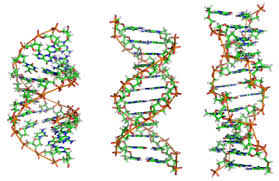what is population movements and genetics??
POPULATION MOVEMENTS AND
GENETICS
 A. Study
of the origins and distribution of human population used to be based on
archaeological and fossil evidence. A number of techniques developed since the
1950s, however, have placed the study of these subjects on a sounder and more
objective footing. The bet information on early population movements is now
being obtained from the ‘archaeology of the living body’, the clues to be found
in genetic material.
A. Study
of the origins and distribution of human population used to be based on
archaeological and fossil evidence. A number of techniques developed since the
1950s, however, have placed the study of these subjects on a sounder and more
objective footing. The bet information on early population movements is now
being obtained from the ‘archaeology of the living body’, the clues to be found
in genetic material.
B. Recent
work on the problem of when people first entered the America is an example of
the value of these new techniques. North-east Asia and Siberia have long been
accepted as the launching ground for the first human colonisers of the New
World. But was there one major wave of migration across the Bering Strait into
the Americas, or several? And when did this event, or events, take place? In
recent years, new clues have come from research into genetics, including the
distribution of genetic makers in modern Native Americans.
C. An
important project, led by the biological anthropologist Robert Williams,
focused on the variants (called Gm allotypes) of one particular protein –
immunoglobin G – found in the fluid portion of human blood. All proteins
‘drift’, or produce variants, over the generations, and members of an interbreeding
human population will share a set of such variants. Thus, by comparing the Gm
allotypes of two different populations (e.g. two Indian tribes), one can
establish their genetic ‘distance’, which itself can be calibrated to give an
indication of the length of time since these populations last interbred.
D. Williams
and his colleagues sampled the blood of over 5,000 American Indians in western
North America during a twenty-year period. They found that their Gm allotypes
could be divided into two groups, one of which also corresponded to the genetic
typing of Central and South American Indians. Other test showed that the Inuit
(or Eskimo) and Aleut formed a third group. From this evidence it was deduced
that there had been three major waves of migration across the Bering Strait.
The first, Paleo-Indian, wave more than 15,000 years ago was ancestral to all
Central and South American Indians. The second wave, about 14,000- 12,000 years
ago, brought Na-Dene hunters, ancestors of the Navajo and Apache (who only migrated
south from Canada about 600 or 700 years ago). The third wave, perhaps 10,000
or 9,000 years ago, saw the migration from the North-east Asia of groups
ancestral to the modern Eskimo and Aleut.
E. How
far does other research support these conclusions? Geneticist Douglas Wallace
has studied mitochondrial DNA in blood samples from three widely separated
Native American groups: Pima-Papago Indians in Arizona, Maya Indians on the
Yucatan peninsula, Mexico, and Ticuna Indians in the Upper Amazon region of Brazil.
As would have been predicted by Robert William’s work, all three groups appear
to be descended from the same ancestral (Paleo-Indian) population.
F. There
are two other kinds of research that have thrown some light on the origins of
the Native American population; they involve the study of teeth and of
languages. The biological anthropologist Christy Turner is an expert in the
analysis of changing physical characteristics in human teeth. He argues that
tooth crowns and roots have a high genetic component, minimally affected by
environmental and other factors. Studies carried out by Turner of many thousands
of New and Old World specimens, both ancient and modern, suggest that the
majority of prehistoric American are linked to Northern Asian population by crown
and root traits such as incisor shovelling (a scooping out one or both surfaces
of the tooth), single-rooted upper first premolars and triple-rooted lower
first motors. According to turner, this ties in with the idea of a single
Paleo-Indian migration out of North Asia, which he sets at before 14,000 years
ago by calibrating rates of dental micro-evolution. Tooth analyses also suggest
that there were two later migrations of Na-Denes and Eskimo-Aleut.
G. The
linguist Joseph Greenberg has, since the 1950s, argued that all Native American
languages belong to a single ‘Amerind’ family, except for Na-Dene and
Eskimo-Aleut – a view that gives credence to the idea of three main migrations.
Greenberg is in a minority among fellow linguists, most of whom favour the
nation of a great many waves of migration to account for the more than 1,000
languages spoken at one time by American Indians. But there is no doubt that
the new genetic and dental evidence provides strong backing for Greenberg’s view.
Dates given for the migrations should nevertheless be treated with caution,
except where supported by hard archaeological evidence.



Comments
Post a Comment